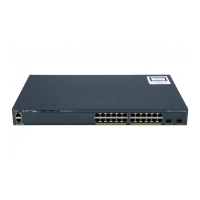CHAPTER
18-1
Catalyst 2960 and 2960-S Switches Software Configuration Guide, Release 15.0(1)SE
OL-26520-01
18
Configuring Optional Spanning-Tree Features
This chapter describes how to configure optional spanning-tree features on the Catalyst 2960, 2960-S,
or 2960-C switch. You can configure all of these features when your switch is running the per-VLAN
spanning-tree plus (PVST+). You can configure only the noted features when your switch is running the
Multiple Spanning Tree Protocol (MSTP) or the rapid per-VLAN spanning-tree plus (rapid-PVST+)
protocol. Unless otherwise noted, the term switch refers to a standalone switch and to a switch stack.
Note Stacking is supported only on Catalyst 2960-S switches running the LAN base image.
For information on configuring the PVST+ and rapid PVST+, see Chapter 16, “Configuring STP.” For
information about the Multiple Spanning Tree Protocol (MSTP) and how to map multiple VLANs to the
same spanning-tree instance, see Chapter 17, “Configuring MSTP.”
Note For complete syntax and usage information for the commands used in this chapter, see the command
reference for this release.
• Understanding Optional Spanning-Tree Features, page 18-1
• Configuring Optional Spanning-Tree Features, page 18-11
• Displaying the Spanning-Tree Status, page 18-19
Understanding Optional Spanning-Tree Features
• Understanding Port Fast, page 18-2
• Understanding BPDU Guard, page 18-2
• Understanding BPDU Filtering, page 18-3
• Understanding UplinkFast, page 18-3
• Understanding Cross-Stack UplinkFast, page 18-5
• Understanding BackboneFast, page 18-7
• Understanding EtherChannel Guard, page 18-10
• Understanding Root Guard, page 18-10
• Understanding Loop Guard, page 18-11

